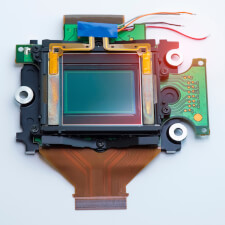CCD
Stands for "Charged Coupled Device."
A CCD is a type of image sensor used to capture still and moving imagery in digital cameras and scientific instruments. A CCD sensor is a flat integrated circuit that contains an array of light-sensitive elements, called pixels, that capture incoming light and turn it into electrical signals. Other components in the device use these signals to construct a digital recreation of the original image.
The quality of the image produced by a CCD depends on its resolution — the number of physical pixels present on the sensor. A sensor's resolution is measured in Megapixels (the total number of pixels in millions). For example, a 16 Megapixel sensor produces an image with twice as many total pixels as an 8 Megapixel sensor, resulting in a more detailed image. A physically-larger sensor can either pack in more pixels than a smaller one, or include larger pixels that are more sensitive to light. CCD sensors can also detect light outside the visible spectrum, enabling infrared photography and night-vision video recording.
Since CCDs only capture the amount of light that hits the sensor, not the color of that light, an unfiltered sensor only produces a monochrome image. CCDs can use red, green, and blue (RGB) filters to capture colored light separately before combining the data into a full-color image. Some devices even include three separate CCDs, one each for red, blue, and green, to capture full-color image data in less time.
While many early digital cameras used CCDs to capture images, other types of image sensors came along that were faster and less prone to overexposure. Eventually, most consumer- and professional-level digital cameras switched to CMOS image sensors. However, CCDs produce higher-quality images when overexposure is not a concern, so they're still used in scientific and medical instruments. They're even used in the harsh environment of space, taking photos of far-off galaxies from orbiting satellite telescopes.
 Test Your Knowledge
Test Your Knowledge